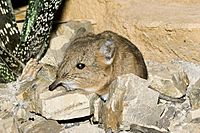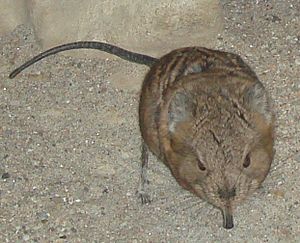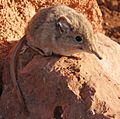Elephant shrew facts for kids
Quick facts for kids Elephant shrews |
|
|---|---|
 |
|
| Short-eared Elephant Shrew (Macroscelides proboscideus) |
|
| Scientific classification | |
| Kingdom: | |
| Phylum: | |
| Class: | |
| Infraclass: | |
| Superorder: | |
| Order: |
Macroscelidea
Butler, 1956
|
| Genera | |
Rhynchocyon |
|
Elephant shrews, also known as sengi, are small mammals from Africa. There are 16 different kinds, and they are about the size of a rat. They get their name from their long, flexible snout, which looks a bit like an elephant's trunk.
These animals have thin bodies, slender legs, and very long back legs and feet. Even though they look like shrews, they are actually not closely related to them. In fact, scientists discovered in the 1990s that elephant shrews are more closely related to elephants than to shrews! They belong to their own special group of mammals called Macroscelidea.
Contents
What Are Elephant Shrews Like?
Elephant shrews are small, four-legged mammals that eat mostly insects. They look a bit like rodents or opossums. They have scaly tails, long snouts, and legs that are quite long for their size. They often move by hopping, similar to rabbits.
Their size can vary a lot. Some are about 10 cm (4 inches) long, while others can be almost 30 cm (12 inches) long. Their weight ranges from less than 50 g (2 ounces) to over 500 g (1 pound). For example, the short-eared elephant shrew is usually about 150 mm (6 inches) long. All elephant shrews can twist their snouts around to find food. In the wild, they usually live for about two and a half to four years. They have large canine teeth and special cheek teeth that are similar to those of ungulates (hoofed animals).
Even though they are active during the day, elephant shrews are hard to spot. They are very cautious, blend in well with their surroundings, and can quickly run away from danger. Some species create clear paths through plants and use these paths to look for insects. If something scares them, these paths give them a quick way to escape.
Elephant shrews are not very social animals. However, many live in pairs, with a male and female sharing and protecting their home area. They mark their territory using special scent glands. Some types, like Rhynchocyon species, dig small cone-shaped holes in the ground, similar to bandicoots. Other types might use natural cracks in rocks or build nests out of leaves.
Short-eared elephant shrews live in dry grasslands and rocky deserts in southwestern Africa. You can even find them in the Namib Desert, which is one of the driest places on Earth. Female elephant shrews will chase away other females, and males will try to keep other males away. Even though they live in pairs, the male and female partners don't spend much time together. Their main reason for being together is to have babies. They often even have separate nests. When their babies are born, they are quite developed and can run within just a few hours.
What Do Elephant Shrews Eat?
Elephant shrews mostly eat insects, spiders, centipedes, millipedes, and earthworms. An elephant shrew uses its long nose to find its food. Then, it uses its tongue to quickly flick small pieces of food into its mouth, much like an anteater.
Eating larger prey can be a bit tricky. If an elephant shrew catches an earthworm, it first pins the worm to the ground with one of its front feet. Then, it turns its head to the side and uses its cheek teeth to chew off pieces, similar to how a dog chews a bone. This can be a bit messy, and small bits of the worm might fall to the ground. But the elephant shrew simply flicks these pieces up with its tongue. Some elephant shrews also eat small amounts of plants, like new leaves, seeds, and tiny fruits.
How Elephant Shrews Evolved
Scientists have found many fossil elephant shrews, all from Africa. These ancient elephant shrews were quite different from the ones we see today. Some, like Myohyrax, looked so much like hyraxes that they were first thought to be part of that group. Others, like Mylomygale, were more like rodents. All these unusual ancient forms died out a long time ago.
For a while, scientists weren't sure where elephant shrews fit in the animal family tree. But now, thanks to studying their bodies and their DNA, we know they belong to a group called Afrotheria. This group includes other African mammals like elephants, manatees, and aardvarks. Elephant shrews are thought to be quite an old and unique branch of this group.
Images for kids
-
R. petersi skeleton, Museum of Osteology
-
North African elephant shrew, Petrosaltator rozeti, Morocco
See also
 In Spanish: Musaraña elefante para niños
In Spanish: Musaraña elefante para niños








